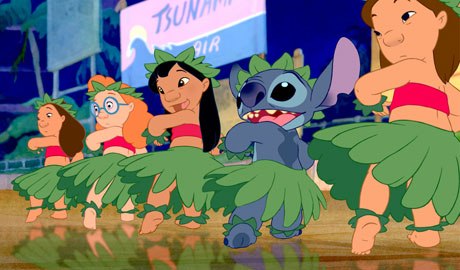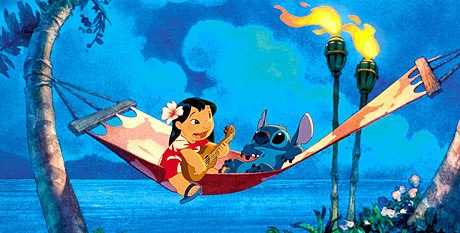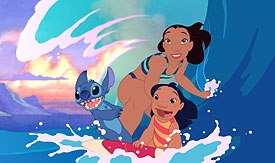In the second part of our interviews with the creatives behind Lilo & Stitch, Andrew Osmond speaks with master animator Andreas Deja about animating Lilo, Hawaii and cartoon punch-outs.

Andreas Deja's working relationship with Lilo & Stitch's co-writers and co-directors Chris Sanders and Dean DeBlois was unusually close since there was no story department to go through. All images © Disney Enterprises, Inc. All rights re
We're honored to be speaking to Andreas Deja, a master Disney craftsman who brought cutely stumpy Hawaiian girl Lilo to animated life. Deja's two-decade tenure has seen him animate Disney heavies -- Gaston, Jafar and Scar -- along with numbskull hero Hercules and two Mickey Mouses (Mickey Mice?) in Runaway Brain and Fantasia 2000.
This interview was conducted in the Dorchester Hotel next door to Chris Sanders, who was recording a Stitch 'voice-over' for a Disney TV special. Somehow a serious conversation about animation technique gains an extra something when it's punctuated by crazy growls and howls...
Andrew Osmond: What was your move to the Florida Disney studio like?
Andreas Deja: I had been involved in Who Framed Roger Rabbit? in London and I worked on the Mickey Mouse short Runaway Brain in Paris. So I was a little bit used to this kind of change, working with a different group of people. This move was in a way the easiest because I knew most people in Florida; a lot of them started in L.A.
They have the most beautiful building in Florida. It seems to me that they've learned from all the mistakes they made before, building new studios. There's lots of space, all the offices have windows, and it's terrific to work in. It was fairly easy getting set up. There's a smaller crew, which is good, because if you work tighter, it seems there are more immediate results and fewer meetings. Chris and Dean didn't have a story department, for example; they storyboarded practically everything themselves. It was pretty much their vision on paper to the animators.

During a research trip to Hawaii, Deja was impressed by the honest and uncomplicated way Hawaiians communicate.
AO: Tell us about your research trip to Hawaii.
AD: I'm really glad I went. On these research trips, it's usually the art directors and background people who go and look at the local colors and sunsets and mountains. People had this idea I might want to check into a local school that teaches Hawaiian tradition and language. We had this Hawaiian tour guide who said, "Well, I don't know if we'll be able to get in because they're very protective of their heritage." But I talked to the teachers a little bit, with the kids looking out of the door, thinking, "Who's this person?" I explained that I worked for Disney and that I worked on these movies and the kids were all going, "Yeah!"
After I was led in, the kids did drawings for me and I sketched for them before class. At one point the teacher said, "The kids would like to greet you now." I thought they would all line up and shake my hand or something. Instead, they stood in front of me and sang the most beautiful Hawaiian greeting song. Just witnessing this, I almost became teary-eyed. It was so genuine and emotional and I felt so privileged. I think that feeling carried over into the movie characters. There was something so honest and uncomplicated about the Hawaiian culture, the way people communicate.

Deja took his cues on how to animate Lilo from her character's complex emotional range.
AO: How did you develop Lilo's designs from Chris Sanders' drawings?
AD: Usually when a supervising animator comes on a movie the first task is to set the design for the character. In the case of Jafar or Scar or some of the other characters, that's my design. In this case, it was really Chris' cast of characters he'd created. Nobody questioned it because we all loved what he had done.
I only had to make sure what he'd drawn stayed intact. There were some slight inconsistencies in the drawings; Chris would even say, "Look, even though we're going to take this design, I draw Lilo a little differently from board to board because I'm not concerned with animation." But I could see the essence of it in a storyboard, and it was up to me to...I don't want to say fine-tune, but make it work for animation and movement. I certainly didn't want to change anything.
AO: How do you create a character? Where do the small mannerisms (for example, the way Lilo flips her hair) come from?
AD: You have to know who a character is, what he or she is feeling at that moment, how they relate to other characters in the scene. You go through the storyboards; you talk with the directors. You think about their all-round personality, down to what the character has for breakfast. The tricky part to get beyond the techniques and open up the animation, make it a personal statement.
As for mannerisms, you do what's appropriate for the scene. With the example of Lilo flipping her hair back over her ear, I actually never had a chance to do that. I wanted to because it was a very "girly" gesture, but it was the other animators working with me who did that.
AO: Tell us about Lilo's acting.
AD: Looking at the first drawings of Lilo, she's pretty caricatured, not that realistic. She's certainly much more caricatured than Snow White or Cinderella or Pocahontas or the other major Disney girls. It seemed that she would have to be animated broader because the design is broad, but on the contrary...Because of who she is, the emotions she's going through and her problems with other characters, I had to be much more selective with the acting patterns.

Deja's early renderings of Lilo were more caricatured, but in the end, he became more selective on how she was portrayed.
That means holding still a lot, which is very difficult in animation. Sometimes you would have a scene where she's just looking at the social worker and not really doing anything, maybe just an eyeblink. Those are the challenges because if you just hold a drawing, the chances are it will die on you. There are exceptions where you hold one drawing for a certain effect, but it usually becomes lifeless. So what you end up doing is a little thing like tilting her head very, very slowly, or having an eyeblink. You have to be right on with the drawing and the expression. Because of the lack of movement, the audience sees that drawing.
I can point at one particular scene that haunted me. It was in the sequence with Lilo and Stitch in the bedroom, looking at the photograph of the parents. Lilo's questioning Stitch about his family. (Lilo voice) "What happened to yours? I hear you cry at night" — and then there was one shot, a clasp of her — (Lilo voice) "I know that's why you wreck things and push me" — and she looks at him out of the corner of her eye. Chris had done this drawing that was just... devastating. I said, "I can't animate this! The drawing represents the emotional movement, so if you add movement, it'll ruin it!"
AO: What was the emotion? Sadness?

From the DVD bonus material "Inter-Stitch-Al," Stitch breaks onto the set of Beauty and the Beast.
AD: It was much more than that. She was saying something that was very difficult for her. She didn't quite want to face him because of that but she was sort of checking him out and turning her head and seeing what his reaction would be... and there was a sort of hesitation in the look. All of that has to be in the scene; it certainly was in the drawing. Of course I kept that pose, but I had her turn away and then come back and that seemed to be the right approach. So she says, (Lilo voice) "I know that's why you wreck things and push me," and then she takes a little look back.
I asked Chris recently, "Do you think I wrecked the scene?" and he said, "No, no, I think it worked!" It was very important to me that I get it right, or at least try my best. Those are the challenges, not the scenes where she's screaming or yelling or biting, easy stuff!
AO: How did Daveigh Chase's voice affect the character?
AD: They found her pretty early and because of that fact, they were saying, "Let's look a little further, test other girls." But we came back to Daveigh because she just seemed to hit the right emotional attitude. It was a big help to have a voice like that. I found her voice very contrasting; it's one thing or the other (laughs). She gets into this big SCREAM when the social worker leaves, after the first meeting didn't go well. Nani does this beautiful look...she waits until the social worker's gone and then it's: "Where are you, you little brat?" (laughs). We cut to Lilo standing in the doorway frozen. I kept one drawing — just one drawing — and that goes into, "AAAAAH!" Then the tremendous scramble begins, Lilo's almost falling over, I have her with one hand on the ground...and off she goes and Nani's after her. There's a great contrast — silence, then this gigantic scream.
AO: No inbetweens at all?
AD: It's straight into the big mouth. I said, "Chris, do you want a little move in the hold?" He said, "No, no! Just one drawing. There's a shocking change we need to get across."

Deja's main concern was to keep Sanders' original visual ideas of the characters intact. Here, Lilo, Nani and Stitch hit the waves.
It was a revealing moment to me when I saw that sequence, the big fight between the two of them. What they're saying, how they yell at each other, and how they make up afterwards was so much like real life. I have an older sister and younger sister and this was just like home back when we were kids. It dawned on me, seeing the storyboards, that a lot of them are very grounded, very earthbound sequences with emotions that are very real, not cartoony. And yet you have Stitch coming in and this element of science-fiction, which I think, makes it a very interesting mix. This whole thing is not all cartoony; the emotions are very real. Even Stitch becomes real, in terms of what he's going through.
AO: You've talked about how Lilo interacts with Nani, but how about other people?
AD: Well, she would like to be friends with the other schoolgirls but it's a challenge for her. They resent her; a girl in her class actually says, "You're weird," when she tells the story of Pudge the fish. That's when she loses it, even Lilo can only take so much. In every screening I've seen, that gets a big laugh because people don't expect it of her, for Lilo to actually punch the girl. Lilo just takes a big leap (laughs) and lets her have it!
AO: At least one U.S. reviewer was extremely shocked by that scene...
AD: You know, it's amazing because animated characters punch each other all the time, whether it's Daffy Duck or Sylvester or even some of the Disney characters. It's common so you wonder why is it so shocking? Because it's a little girl, it's unexpected, and I think she comes out as being believable. If the audience just sees another cartoon character, they wouldn't care, they wouldn't even laugh — but Lilo gets this big reaction, which I find amazing, absolutely amazing.
With the teacher, it's her impatience. (Teacher voice) "Lilo why are you late?" — She goes into this, (Lilo voice, sigh) "Here we go again, every Thursday I have to explain it again, feed Pudge the fish a peanut-butter sandwich, don't you get it? Don't you understand?" She gets impatient with him because she can't be understood; she sees her things her way and can't understand why other people can't see them that way too.
AO: How about her interaction with Stitch?
AD: From very early on, she is determined to deal with him. He's mean, he pushes her, he doesn't behave like a dog should (laughs) but she goes for dog training and uses a water pistol... She is determined to turn him into a good thing. It's her project; she doesn't want to give up. When Stitch comes into her room for the first time, he does this monstrous snarl. She sees it and says, (Lilo voice) "Look how curious this puppy is!" (laughs) — completely innocent, you know? (Lilo voice) "This is my room, this is mine, this is your bed, this is your dolly and bottle, doesn't spill"...She's just like a real kid and determined to deal with him.
Because of the different relations Lilo has to all the characters, it makes her a very rich character herself.
Andrew Osmond is a freelance writer specializing in fantasy media and animation.







